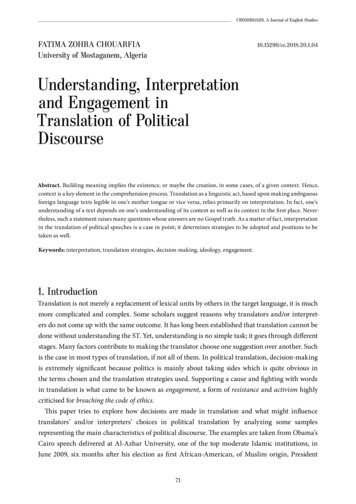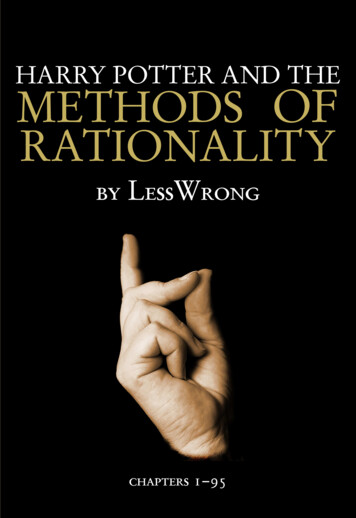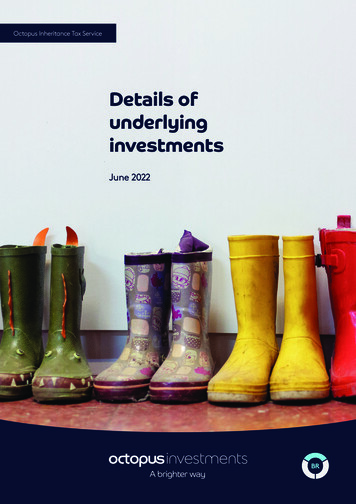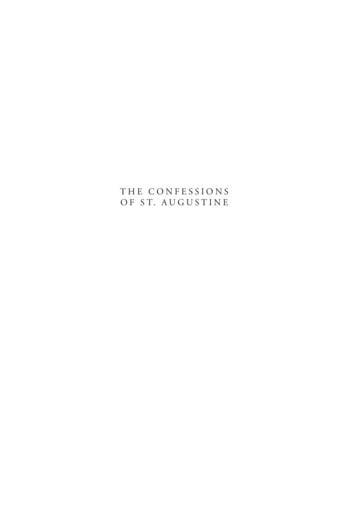
Transcription
Twenty-Five Years ofIdeological HomicideVictimization in theUnited States of AmericaReport to the Office of University Programs,Science and Technology Directorate,U.S. Department of Homeland SecurityMarch 2016National Consortium for the Study of Terrorism and Responses to TerrorismA Department of Homeland Security Science and Technology Center of ExcellenceLed by the University of Maryland8400 Baltimore Ave., Suite 250 College Park, MD 20742 301.405.6600www.start.umd.edu
National Consortium for the Study of Terrorism and Responses to TerrorismA Department of Homeland Security Science and Technology Center of ExcellenceAbout This ReportThe authors of this report are Dr. William S. Parkin, Department of Criminal Justice, Seattle University; Dr.Steven M. Chermak, School of Criminal Justice, Michigan State University; Dr. Joshua D. Freilich, DoctoralProgram in Criminal Justice, The Graduate Center & John Jay College, CUNY; Dr. Jeff Gruenewald, School ofPublic and Environmental Affairs, Indiana University – Purdue University Indianapolis. Questions aboutthis report should be directed to Dr. William S. Parkin at parkinw@seattleu.edu.This research was supported by the Department of Homeland Security Science and TechnologyDirectorate’s Office of University Programs through Award Number 2012-ST-061-CS0001, Center for theStudy of Terrorism and Behavior (CSTAB), made to START to investigate the understanding andcountering of terrorism within the U.S. The views and conclusions contained in this document are thoseof the authors and should not be interpreted as necessarily representing the official policies, eitherexpressed or implied, of the U.S. Department of Homeland Security or START.About STARTThe National Consortium for the Study of Terrorism and Responses to Terrorism (START) is supported inpart by the Science and Technology Directorate of the U.S. Department of Homeland Security through aCenter of Excellence program led by the University of Maryland. START uses state‐of‐the‐art theories,methods and data from the social and behavioral sciences to improve understanding of the origins,dynamics and social and psychological impacts of terrorism. For more information, contact START atinfostart@start.umd.edu or visit www.start.umd.edu.CitationsTo cite this report, please use this format:Parkin, William S., Steven M. Chermak, Joshua D. Freilich, and Jeff Gruenewald. “Twenty-Five Years ofIdeological Homicide Victimization in the United States of America,” Report to the Office of UniversityPrograms, Science and Technology Directorate, U.S. Department of Homeland Security. College Park, MD:START, 2016.Twenty-Five Years of Ideological Homicide Victimization in the United States of America
National Consortium for the Study of Terrorism and Responses to TerrorismA Department of Homeland Security Science and Technology Center of ExcellenceContentsIntroduction . 1Inclusion Criteria . 1Results . 2Conclusion . 7Twenty-Five Years of Ideological Homicide Victimization in the United States of America
National Consortium for the Study of Terrorism and Responses to TerrorismA Department of Homeland Security Science and Technology Center of ExcellenceIntroductionThis brief report presents the preliminary results of 25 years of ideological victimization committed byal-Qa’ida and affiliated movements and the extremist far-right in the United States from 1990 to 2014.Excluding the homicide victims associated with the four attacks on 9/11 and the Oklahoma City bombing,62 individuals were killed in 38 ideologically motivated homicide events committed by extremistsassociated with al-Qa’ida and affiliated movements1 and 245 were killed by far-right extremists in 177ideologically motivated incidents. The data for this report originates from the United States ExtremistCrime Database (ECDB), an open-source dataset that examines ideologically motivated and routinecriminal activity, both violent and financial, committed by ideological extremists. Although the results ofincident and suspect data have been released, this is the first report that focuses solely on victimizationcharacteristics. In addition, this report also compares two distinct types of ideological victimization,homicides committed by adherents to far-right extremism (FRE) in the U.S. and those committed byindividuals who associate themselves with al-Qa’ida and affiliated movements (AQAM).Inclusion CriteriaThis report includes all homicide victims identified in open-source materials who satisfied the ECDB’sinclusion criteria.2 Specifically, our inclusion criteria for each victim comprises that: The victim was killed in a homicide event identified in open-sources At least one of the offenders involved in the incident was an ideological extremist The homicide event was ideologically motivated3 The extremist ideology to which the offender adhered and the incident was motivated wasconnected to al-Qa’ida and affiliated movements or far-right extremism41This numbers also includes one homicide victim killed in an ideologically motivated, secular nationalist incident.For an in-depth discussion about the data collection process for the ECDB and the reliability and validity of the data, pleasesee “Freilich, J., Chermak, S., Belli, R., Gruenewald, J., & W. Parkin. (2014). Introducing the Extremist Crime Database (ECDB).Terrorism & Political Violence, 26, 372-384” and “Chermak, S., Freilich, J., Parkin, W., & J. Lynch. (2012) American Terrorismand Extremist Data Sources and Selectivity Bias: An Investigation Focusing on Homicide Events Committed by Far-RightExtremists. Journal of Quantitative Criminology, 28(1), 191-218”2A homicide was coded as ideologically motivated if specific indicators were identified that provide evidence that the offenderengaged in the fatal, criminal act based at least partly on their extremist ideology. These indicators could include, but are notlimited to, personal statements made by the offender, physical evidence such as a note or manifesto, or comments made by lawenforcement or lawyers stating that the motive was ideological. For a longer discussion on these indicators and determininghow coders determined whether an incident was ideologically motivated or not, see “Gruenewald, J. (2011). A comparativeexamination of homicides perpetrated by Far-Right Extremists. Homicide Studies, 15(2), 177-203” and “Parkin, W., Freilich, J. &S. Chermak. (2015). Ideological Victimization: Homicides Perpetrated by Far-Right Extremists. Homicide Studies, 19(3), 211236.”3Twenty-Five Years of Ideological Homicide Victimization in the United States of America1
National Consortium for the Study of Terrorism and Responses to TerrorismA Department of Homeland Security Science and Technology Center of Excellence The victim was killed within one of the 50 states or the District of ColumbiaThe victim was killed between January 1, 1990 and December 31, 2014ResultsBetween 1990 and 2014, 62 individuals were killed by AQAM offenders in 38 incidents (1.6 victims perhomicide incident) and 245 individuals were killed by FRE offenders in 177 incidents (1.4 victims perhomicide incident). Once again, this does not include the nearly 3,000 individuals killed in the 9/11attacks perpetrated by AQAM offenders or the 168 individuals killed in the Oklahoma City bombingperpetrated by FRE offenders. Table 1 presents these results, as well as temporal and geographiccharacteristics of ideological homicide victimization.The temporal distribution of the homicide victimizations varies between the two ideologies. For theAQAM victims, only slightly more than 16 percent were killed prior to the year 2000, compared to slightlymore than 45 percent of FRE victims. Although the numbers of victims are relatively smaller for AQAM,almost two-thirds of their victims were killed during the 10-year period between 2000 and 2009. FREvictims, on the other hand, appear to be killed in cycles, with the first half of each decade consistentlybeing lower than the second half. Although research has shown fluctuations in violent crime trends basedon seasonality, the temporal distribution of ideological victimization does not appear to be consistentwith this research, at least for AQAM victims. More than half of AQAM victims were killed during the falland slightly less than a quarter during the winter. FRE victims, whose temporal distribution is moresimilar to trends found in homicide victimization in general, were more likely to be killed during thespring or summer (60.8%), and least likely to be killed during the fall and winter (38.8%).As operationalized in Freilich et al (2014:380), “Far-right extremists subscribe to aspects of the following beliefs: They arefiercely nationalistic, anti-global, suspicious of federal authority, and reverent of individual liberties, especially their right toown guns and be free of taxes. They believe in conspiracy theories involving imminent threats to national sovereignty orpersonal liberty and beliefs that their personal or national ‘way of life’ is under attack. Sometimes such beliefs are vague, butfor some the threat originates from specific racial or religious groups. They believe that they must be prepared to defendagainst this attack by participating in paramilitary training or survivalism,” while Al-Qa’ida and associated movements “adhereto aspects of the following beliefs: They believe that only acceptance of Islam promotes human dignity. Islamic extremistsreject the traditional Muslim respect for ‘People of the Book’ (i.e., Christians and Jews). They believe that ‘Jihad’ (i.e., tostruggle in God’s path like the Prophet Muhammad) is a defining belief in Islam and includes the ‘lesser Jihad’ that endorsesviolence against ‘corrupt’ others. Islamic extremists believe that their faith is oppressed in nominally Muslim MiddleEastern/Asian corrupt governments and in nations (e.g., Russia/Chechnya) that occupy Islamic populations. The U.S. is seen assupporting the humiliation of Islam, and exploiting the region’s resources. They believe that America’s hedonistic culture (e.g.,gay rights, feminism, etc.) negatively affects Muslim values. Islamic extremists believe that the American people areresponsible for their government’s actions and that there is a religious obligation to combat this assault. They believe thatIslamic law—Sharia—provides the blueprint for a modern Muslim society and should be forcibly implemented.”4Twenty-Five Years of Ideological Homicide Victimization in the United States of America2
National Consortium for the Study of Terrorism and Responses to TerrorismA Department of Homeland Security Science and Technology Center of ExcellenceTable 1. Temporal & Geographic Characteristics of Ideological Homicide .8%Fall3251.6%4618.8%Unknown00.0%10.4%Census uth3556.5%8133.1%West1117.7%8534.7%Census DivisionEast North Central34.8%218.6%East South n23.2%4116.7%New England69.7%145.7%Pacific914.5%4418.0%South Atlantic1321.0%3213.1%West North Central00.0%124.9%West South Central1625.8%2711.0%*These numbers do not reflect the nearly 3,000 victims killed in the AQAM terroristattacks in New York, Virginia, and Pennsylvania on September 11, 2001 and the 168victims killed in the FR terrorist bombing in Oklahoma on April 19, 1995.Twenty-Five Years of Ideological Homicide Victimization in the United States of America3
National Consortium for the Study of Terrorism and Responses to TerrorismA Department of Homeland Security Science and Technology Center of ExcellenceTable 2. Incident Characteristics of Ideological Homicide VictimizationTargetingIdeologicalMotivationVictim TypeLine of DutyOnly Fatal VictimOthers InjuredPrimary rLaw EnforcementMilitaryYesYesFirearmKnifeBodily WeaponBlunt ObjectOtherUnknownAQAMN 0.6%44.4%79.4%72.6%8.1%0.0%6.5%8.1%4.8%FREN .7%The geographic distribution of victimizations also varied, 56.5 percent of AQAM victims died in the South,followed by the Northeast (21.0%), West (17.7%), and Midwest (4.8%). For the FRE victims, the pluralitywas killed in the West (34.7%), followed closely by the South (33.1%). The percentage of FRE victimswho were killed in the Northeast and Midwest were also relatively close (18.8% and 13.5%,respectively). When broken down by census division, we find the largest differences in the percentage ofvictims killed across ideologies in the Mountain and West South Central areas. In the Mountain states(Arizona, Colorado, Idaho, Montana, New Mexico, Utah, Colorado), almost 17 percent of FRE victims werekilled, compared to slightly more than 3 percent of AQAM victims. Conversely, 25.8 percent of AQAMvictims were killed in West South Central States (Arkansas, Louisiana, Oklahoma, Texas), compared to 11percent of FRE victims.Twenty-Five Years of Ideological Homicide Victimization in the United States of America4
National Consortium for the Study of Terrorism and Responses to TerrorismA Department of Homeland Security Science and Technology Center of ExcellenceExamining individual and incident level characteristics across ideologies identifies both similarities anddifferences in the types of victims killed by AQAM and FRE extremists in the United States (Table 2).When examining levels of targeting, we find that FRE victims were more often purposefully targeted foran ideological homicide than AQAM victims (43.3% to 19.4%, respectively). This is to say that theoffenders knew of the victims and purposefully decided to kill them for ideological reasons. However,there was little difference in the percentage of victims who were targeted for what they represented(37.1% versus 38%). In these victimization events, ideological offenders targeted their victims notbecause they knew of them, but because they represented something that was antithetical to theirideology, such as a military officer or a bi-racial couple. The last type of targeting behavior examined isthat related to random victimization. In these homicide incidents, these individuals are chosen neither forwhat they represent, nor purposefully based on the offenders’ prior knowledge of the victim, but wereconsidered victims of “random chance.” Random targeting was more prevalent among AQAM-relatedhomicides, at 19.4 percent of all events, as compared to FRE homicides, at 9.4 percent.The next incident level variable measures the ideological motivation behind the homicide incident. In theECDB, an ideological event can range from 1 to 4, where 1 represents a low level of ideological motivationfor a victimization event and 4 represents a high level of ideological motivation for a victimization. Inevents coded with a low level of ideological motivation, there is a single indicator that points toward theevent being ideologically motivated, while there is also evidence that the victimization might not beideologically motivated. For a high level of ideological motivation, there are multiple indicators ofideological motivation and no indicators that question whether or not it was ideologically motivated.5Victimization events coded as a medium level of ideological motivation had either a single piece ofevidence supporting ideological motivation and no contradictory evidence or multiple pieces of evidencesupporting an ideological motive and at least one contradictory piece of information. Far-right extremistvictims were more likely to be killed in events with a high level of ideological motivation when comparedto AQAM violence (46.5% to 39.7%, respectively), but also were more likely to have a higher level of lowideological motivation (13.9% to 4.8%, respectively).For victim type, the majority of AQAM victims were civilian targets, while the second largest category wasgovernment victims. For the government victims, this is partially connected to another variable, whichshows more than 20 percent of AQAM victims were in the military and killed in the line of duty.Compared to this, FRE victims were most often targeted for racial or ethnic reasons, specifically as theirAn example of a victimization event with a high level of ideological motivation would be the murder of an African-Americanand his friend by a group of skinheads. Immediately prior to the homicide the offenders remarked that they were disappointedskinheads were less active in their area and felt they needed to do something, decided to search for victims in a neighborhoodwhere they knew minorities lived, and specifically targeted a minority and his friend, who was white, for being a race traitor.There was no evidence of an alternative motive. On the other side of the ideological motive spectrum, a victimization eventcoded as low ideological motivation will have mixed support. For example, a the murder of a minority by a white supremacistwas coded as ideologically motivated as officials stated race played a part in the killing; however, there was also evidence thatthe offender may have acted in self defense, plus there was a history of prior conflicts between the victim and offender.5Twenty-Five Years of Ideological Homicide Victimization in the United States of America5
National Consortium for the Study of Terrorism and Responses to TerrorismA Department of Homeland Security Science and Technology Center of Excellencestatus as minorities. This was followed by civilian targets (28.1%) and then government targets,primarily law enforcement officers killed in the line of duty (12.7%).Table 3. Individual Characteristics of Ideological Homicide VictimizationAgeSexRace 1010-1920-2930-3940-4950-59 59UnknownFemaleMaleUnknownAsianBlackHispanic (any race)WhiteOtherUnknownAQAMN .5%FREN .3%48.2%4.9%0.8%In 44.4 percent of AQAM cases, there was only one homicide victim, while 79.4 percent of fatal victimswere killed in incidents where another individual was injured. For FRE victims, 60.4 percent were thesole fatality, and 47.3 percent were killed in homicide incidents where another individual was violentlyvictimized, but not fatally. Finally, 72.6 percent of AQAM victims were killed by a firearm, compared to62.9 percent of FRE victims, who were more likely than AQAM victims to be killed with a knife or bodilyweapon.Table 3 presents individual level characteristics of the ideological victims, specifically basic demographicdata. Although the age of FRE victims appears to be normally distributed, peaking around the ages of 40to 49 (22.0%), the ages AQAM victims peak in the age category of 20 to 29 (32.3%), but also are high inthe older category of 50 to 50 (21.0%). For sex, FRE victims are more often male when compared toAQAM victims (81.6% to 71.0%, respectively). In addition, there are no severe deviations in race andethnicity between the two types of ideological victims, with the largest departure between the twooccurring for victims who were Black. In this instance, FRE victims were Black 32.7 percent of the time,while AQAM victims were Black only 24.2 percent of the time.Twenty-Five Years of Ideological Homicide Victimization in the United States of America6
National Consortium for the Study of Terrorism and Responses to TerrorismA Department of Homeland Security Science and Technology Center of ExcellenceConclusionOver the last 25 years, when including the ideological victims of the 9/11 terrorist attacks and theOklahoma City bombing, offenders associated with AQAM have killed nearly seven and half times morepeople than FRE in one-fifth as many incidents. However, when these two outliers are removed, anotherstory unfolds. Under these circumstances, there are nearly four times as many FRE victims as AQAM. Thepurpose of this analysis is not to discount the victims of these events, but to examine ideologicalvictimization without the disproportionate impact of such catastrophic acts of terrorism.For the most part, these two types of ideological victimization appear to be more unique than similar. It isthus important to, as this study did, disaggregate the study of terrorism by ideology. Victims of AQAMwere killed at different times and in different locations when compared to FRE victims. AQAM victimswere killed in events that more often had multiple victims, where others were injured, and the use of afirearm was the primary weapon of the offender. FRE victims were more often the sole victim (both fataland not), and although a firearm was still the primary weapon used, they were more likely than AQAMvictims to be stabbed or beaten to death. Although both sets of victims had disproportionate numbers ofindividuals killed in the line of duty, especially when one considers the percentage of the generalpopulation engage in active military or law enforcement service at any given point in time, AQAM victimswere more likely to be military, while FRE victims were more likely to be law enforcement. Finally, AQAMvictims were younger (45.2% were under 30, compared to 31% of FRE victims) and more often female,when compared to FRE victims (25.8% to 18%, respectively).In some ways, AQAM victims appear to have characteristics that are slightly closer to that of “typical”homicide victims and even the general population. This could be a mechanism of the fact that AQAMvictims are much more likely to be random or representative victims than are FRE victims. In thesecircumstances, it could be argued that a victim’s routine activities and lifestyle play a larger role in theirrisk of ideological victimization. If an individual is fatally victimized by an AQAM offender depends onwhether they are in the proverbial wrong place at the wrong time. FRE victims, however, are more likelyto be targeted purposefully for assassination based on the offender’s previous knowledge of theindividual. In these circumstances, their lifestyle and routine activities only dictate when and where, notif, they are victimized. These victimization patterns over the last 25 years demonstrate that ideologicalvictimization from terrorist and extremist violence varies across ideologies and underlines theimportance of future research in the fields of criminology and victimology in attempting to understandthese differences and reduce victimization risk.Twenty-Five Years of Ideological Homicide Victimization in the United States of America7
Led by the University of Maryland 8400 Baltimore Ave., Suite 250 College Park, MD 20742 301.405.6600 www.start.umd.edu Twenty-Five Years of Ideological Homicide Victimization in the United States of America Report to the Office of University Programs, Science and Technology Directorate, U.S. Department of Homeland Security March 2016










